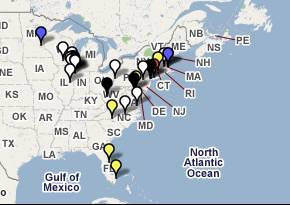By paulgillin | March 11, 2008 - 7:32 am - Posted in Paywalls
Bay Area Newspaper Group (BANG) was able to avoid involuntary layoffs because 107 out of 1,100 employees took a recent buyout offer. The cuts affect the Contra Costa Times, Oakland Tribune and 14 other daily and weekly newspapers. The president of the company said he couldn’t guarantee there wouldn’t be more cuts. BANG executives cited a “drastic economic slump.”
Down the coast, ex-SJ Mercury employees are taking to the blogosphere to ponder the paper’s future, if it has one. A sampling:
- Ryan Sholin offers proscriptions for the Merc on his blog. They including ending the ghettoization of bloggers and podcasters, ditching the focus on national news and switching software platforms.
- Meanwhile, more than 100 members of the San Jose Newspaper Guild’s Mercury News unit dressed in black and rallied in front of the paper to show their support for laid-off workers. Oft-quoted Guild unit president Sylvia Ulloa vowed to show management that employees are “united, not intimidated.” That works okay when the owners are making money, but that doesn’t seem to be the case these days.
- Michael Bazeley writes an early obit for the Merc. He doesn’t blame the new owners as much as some other disenfranchised ex-employees, but rather sees the Merc’s troubles as being rooted in rudderless leadership and lack of vision. When technology journalism exploded, the Merc stood still, he says. That was its big opportunity and the paper blew it. Now, he concludes, “I fear the paper will not recover.”
- Robert Butche writes not about the Merc but about the shockwaves of fear that the firing of LA Times editor James O’Shea sent through newsrooms and protests that “owners devoid of newspaper experience have been lulled into believing that a newspaper can flourish and survive by downsizing.” True ’nuff. The problem is that when the business shows declining readership, declining advertiser interest and no long-term hope of reversing those trends, an aggressive investment strategy isn’t a very palatable option, either.
Comments Off on Bay Area Group Avoids Layoffs; Ex-Merc Journos Lament What Should Have Been

 Zell visited the Washington bureau of the LA Times and said its 47-person staff is “bloated.”
Zell visited the Washington bureau of the LA Times and said its 47-person staff is “bloated.” 

